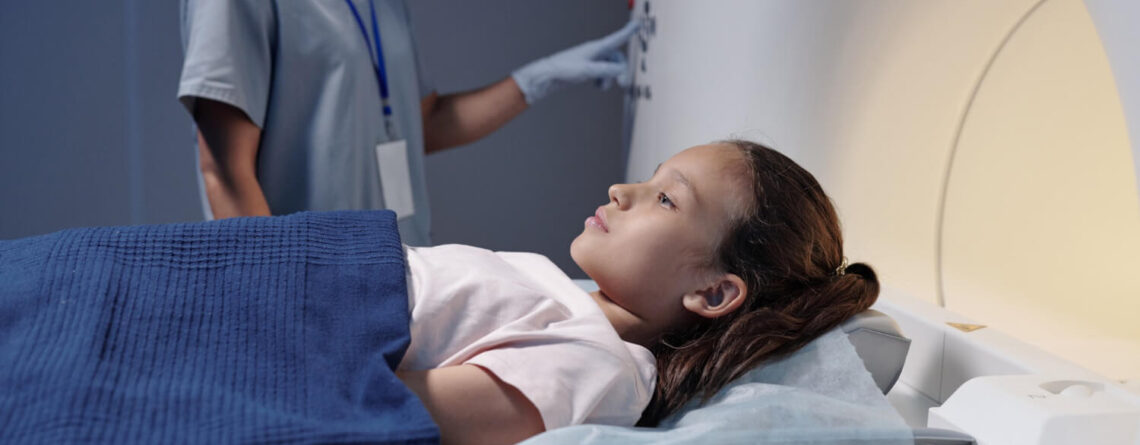Lessions in the neck area can be benign or malignant, have a congenital nature or appear after birth under various factors influence (injuries, infections, etc.). Any neoplasm in the neck area requires the attention of specialist, because even benign neoplasms can cause health and life-threatening complications, for example, compress vital anatomical structures in the neck area (larynx, esophagus, main vessels and nerve fibers).
Neoplasm appearance on the neck can be noticed by child himself, his parents or a doctor during preventive examination. Neoplasm can be painless or, on contrary, cause pain, which primarily depends on its cause. Very often, such neoplasms in the neck area have an asymptomatic course, which leads to their rather late detection.
Tumors in the neck area in children are quite common and account for 15% of all neoplasms in children's body. Malignant lesions among neck neoplasms make up 10%.

If you notice something similar to a tumor in your child's neck area, don't delay a visit to the doctor . Specialists of Pediatric Oncology Department of Maimonides Multidisciplinary Medical Center will help you deal with this situation in the shortest possible time, while you will receive Israeli template medical care without leaving Ukraine.
e work closely with the best Israeli Pediatric Oncology Centers. Children's oncology project of Maimonides Medical Center is managed by Dr. Serhiy Postovsky directly from Israel . Together with our head of Pediatric Oncology Department, Dr. Yuriy Tymoshchuk , he takes an active part in management of each individual clinical case. Dr. Oshri Wasertzug from Tel Aviv Medical Center is also responsible for surgical direction of ENT pathology in children.
We know that oncological diseases treatment, especially malignant ones, is a very expensive process, so we have created conditions for our patients to receive financial assistance for treatment. Maimonides Medical Center works under the patronage of “Keren Or for our Child” the Charitable Foundation.
Also, all our doctors are highly qualified, they have repeatedly trained on the basis of pediatric oncology leading foreign departments. We have to mention, that they know how to find connection with any child quickly, and in case of very difficult situation, a professional child psychologist will come to rescue.
Making up a diagnostic and treatment plan, specialists of Maimonides Medical Center are guided only by modern protocols built on principles of evidence-based medicine. At the same time, approach to each i individual patient is individual.
Not only oncologists work in the department. Neoplasm in the neck area is a complex pathology that may require certain narrow specialists involvement in treatment and diagnostic process. That's why specialists of our department includes general surgeons, endocrinologists, vascular surgeons, neurosurgeons, radiation therapists, chemotherapists, ENT doctors, rehabilitation specialists, speech therapists, psychologists. This provides access for every sick child to continuity of medical services, that is, the entire range of care can be obtained within the walls of one institution, starting from initial consultation and diagnosis, ending with rehabilitation after complex treatment.
Causes and types of neck area tumors
Neoplasms in the neck can develop for many reasons.
The following are most common:
- Action of infectious agents – infectious mononucleosis (Ebstein-Barr virus), various viral or bacterial oropharyngeal lesions, HIV and AIDS, tuberculosis, primary bacterial lymphadenitis.
- Malignant lesions – cancer of oropharynx, salivary glands, thyroid gland, lymphoma, metastatic lesions of cervical lymph nodes.
- Congenital defects – dermoid cyst, congenital neck cysts, thyroglossal duct cyst.
- Other disorders – diffuse goiter, nodular goiter, enlargement of sublingual salivary gland (salivary gland stone – sialoadenitis), neck lipomas, atheroma, other benign neoplasms, etc.
Most often, children have the following neoplasms in the neck area:
- Lymphangiomas of neck are benign neoplasms from lymphatic vessels that are congenital in nature.
- Bronchogenic cysts of neck is a congenital abnormality of branchiogenic glands development that occurs during fetal development, is benign in nature, and can reach significant sizes.
- Dermoid cyst in neck is a benign neoplasm that is congenital in nature. It is distinguished by slow growth and is not always diagnosed at birth. Such a cyst is detected when it reaches significant sizes and becomes noticeable in child’s neck area.
- Branchial Cleft Cyst are congenital neoplasms of benign nature that are formed during 4-5 weeks of child’s intrauterine development.
- Lingual thyroglossal duct cysts (TGDC) is a benign congenital neoplasm located at the lower pole of thyroid gland in hyoid bone region. This neoplasm can become malignant in the process of its growth, so it definitely needs quick surgical treatment.
- Lymphangiomatosis of tongue and lips is a congenital abnormality of lymphatic vessels development that can be localized in the area of tongue and lips.
- Fibromatosis of neck is a congenital benign tumor in the neck area of baby, which leads to muscular torticollis, and therefore requires immediate surgical treatment.
- Juvenile angiofibroma of nasopharynx is a benign neoplasm with a high risk of recurrence and transformation possibility into a malignant tumor.
Even benign neoplasms in the neck area require doctor’s close attention, as they can squeeze arteries, veins, nerves, larynx, spinal cord, and therefore are considered no less dangerous to life than malignant tumors.

What symptoms can be observed with neck neoplasms?
Not all pathologies in the neck area are manifested by pronounced symptoms. Most of them are asymptomatic until complications develop. As a rule, neoplasms in the neck area are discovered accidentally during examination for another reason. But despite this, all of them should be evaluated by a specialist, because some of them carry a serious threat.
Signs of lession depend on its cause, type, location, growth rate, complications presence, for example, compression syndrome.
The most frequent complaints of neoplasms in the neck area are:
- Swelling, compaction in the neck area, which can be seen or palpated, can be mobile or fused with surrounding tissues, painful or completely painless, of different shapes and sizes, consistency.
- Disruption of swallowing process (dysphagia) or pain during it.
- Difficulty breathing.
- Pain in the area of tumor is constant or during palpation.
- Redness of skin over the neoplasm.
- General symptoms – prolonged fever, general weakness, lack of appetite, increased sweating, especially at night, etc.
- "lump" feeling in throat, dry irritating cough.
- Voice changes – hoarseness or loss.
Modern diagnostics methods
Any diagnostic process begins with complaints collection from patient or his parents, life and illness history, examination and objective examination. Based on received information, specialist establishes a preliminary diagnosis (there are often several of them), prescribes a set of additional laboratory and instrumental examinations to clarify the process and carry out differential diagnosis.
General clinical and biochemical blood tests are necessarily prescribed, in case of suspicion of an infectious lesion – various tests to establish inflammation etiology (PCR, serological blood test, swabs from oropharynx, etc.).
If malignant nature of disease or specific diseases (for example, tuberculous lesion of cervical lymph node) is suspected, a biopsyis performed. Obtained histological material must be sent to pathohistological laboratories in Israel, USA, and Germany for revision. Thanks to such double checks, we are absolutely sure of diagnosis correctness and prescribed treatment adequacy.
Very often neoplasms in the neck area, especially those of oncological or congenital nature, require detailed imaging. For this, endoscopy, ultrasound, radiography, CT, MRI with or without contrast, PET-CT, PET-MRT are used.

Treatment methods of neoplasms in the neck area in children
Some neoplasms (inflammatory and infectious in nature) pass on their own and do not require specific therapy. The rest of neoplasms require modern and accurate diagnosis with type of process establishment, its distribution, stage and size with followed comprehensive treatment appointment. Treatment success depends on a full-fledged examination, which is why Maimonides Medical Center pays a lot of attention to diagnostic stage.
As a rule, drug therapy is prescribed for neoplasms of infectious, inflammatory nature. Depending on cause, patient is prescribed antiviral, antibacterial, and antiparasitic drugs. In our practice we use only original drugs from leading pharmaceutical manufacturers. So we are sure of treatment effectiveness and its safety.
Surgical intervention is the basis of treatment of all congenital neoplasms in the neck area and many acquired ones, including malignant. Our ENT surgeons have extensive experience in performing all types of surgeries. This allows us to perform interventions of any complexity level. We provided surgery even to that patients who were refused a similar intervention in other medical institutions due to the lack of surgeon’s experience or specific medical and diagnostic equipment. Radiotherapy is necessary in case of malignant neoplasm or a high malignancy risk.
Radiation therapy can be remote with the help of linear accelerators, when radiation source is outside the body. This method of radiation therapy is used for most neck tumors, it has good results, but it also has many side effects.
The most common are xerostomia (irreversible damage to salivary glands), widespread caries development after a course of radiation, and osteoradionecrosis (a part of upper or lower jaw bone death). To avoid such complications in our patients, we use only modern safe radiation therapy machines, modified radiation techniques, for example, radiation therapy with intensity modulation.
Also, radiation therapy can be contactcontact, when radioactive isotopes are placed in a certain capsule and installed directly inside a malignant neoplasm. For neck tumors, this method is almost never used, although it has significantly fewer side effects compared to remote radiation. An example of contact radiotherapy is radioiodine therapy for malignant lesions of thyroid gland. In this case, radioactive isotopes of iodine are injected into body, which accumulate directly in thyroid gland tissue and exert their effect directly there, without affecting surrounding healthy tissues.
Chemotherapy is also used in complex treatment of neck malignant tumors. We use only approved and safe chemotherapy drugs, according to modern treatment protocols. Chemotherapy can be prescribed before, instead of or after surgery (it all depends on the main diagnosis and the stage of process). Innovative methods such as target therapy, immunobiological therapy, and hormone therapy are also used in complex treatment of malignant tumors.
An absolute bonus for our patients is the opportunity to participate in clinical trials of experimental drugs absolutely free of charge. For some children, this is a real chance for a full recovery, especially for those for whom all standard treatment regimens, unfortunately, have turned out to be ineffective.

